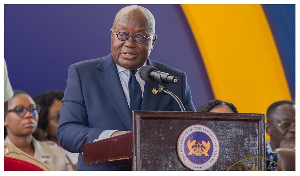Accra, March 10, GNA - Dana Petroleum Plc (Dana) and Ghana National Petroleum Corporation (GNPC) have announced the discovery of oil in the Western Tano Contract Area, about 20 miles offshore, with flow rate of up to 1000 barrels a day.
The spot, in 380 feet of water, has a bottom hole pressure data, which indicated that future development wells using artificial lift could produce at much higher rates.
Making the announcement at a press briefing at the close of the Fourth Oil and Gas Africa 2000 Conference in Accra, on Thursday, Mr John Craven of Dana, however, said it was not possible to say when production and its associated activities would begin until a comprehensive evaluation is done.
He said the well was sunk to explore the oil and gas potential of both Upper Cretaceous and Lower Cretaceous age sediments in the shallow water shelf region and gain a better understanding of the neighbouring deep water fan prospects, by testing reservoir development and source rock maturity.
The drilling of the well, christened WT-IX, began in December 1999 and reached a total measured depth of 10,414 feet and subsequent testing and wireline logging proved that hydrocarbons were present in both the Upper and Lower Cretaceous sands.
In the Upper Cretaceous, a 150 feet gross oil column was discovered in a channel sand sequence and after a drill stem test over this interval, flowed clean oil of approximately 20 degrees API with flow rates of up to a 1000 barrels a day.
Mr Craven said the Lower Cretaceous horizon was entered at approximately 9500 feet and drilling measurement indicated that hydrocarbons were present at abnormally high pressures.
Drilling continued to 10,000 feet and wireline logs were run, which confirmed the presence of lighter oil in porous sandstone with much higher pressures and gas levels relative to the Upper Cretaceous.
Because logs indicated oil down to 10,000 feet a decision was made to drill deeper to determine the total extent of oil-bearing sands, he said. However, following problems caused by overpressure while drilling deeper, the partners made a decision to stop drilling at 10,414 feet and plug the lower section of the well on safety grounds.
Consequently, it was not possible to conduct a flow test from the Lower Cretaceous interval, however, future wells would be designed to accommodate the high pressures encountered, thus enabling this horizon to be flow tested.
"Well WT-IX has been temporarily suspended and kept for potential future use as an oil producer", he said. "The results of the well will be integrated with GNPC's existing high quality 3D seismic data over the WT-IX area to determine the commercial significance of the discovery and plan for future work".
Tom Cross, Dana's Chief Executive, said, the discovery confirms the belief that there is considerable potential in the Western Tano area and shows the expertise and dedication of the exploration teams in Dana and GNPC.
Mr Tsatsu Tsikata, Chief Executive of GNPC was quoted as saying, "the well is important not only for what has been tested, and encountered but even more for heralding what we see as a new chapter in unearthing Ghana's exploration potential.
"The location of these additional reserves near the North and South Tano Fields is also significant for our development plans". Dana holds 90 per cent ownership while GNPC has 10 per cent in WT-IX but can increase it 25 per cent during commercial development.
General News of Friday, 10 March 2000
Source: GNA
















